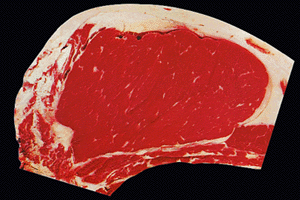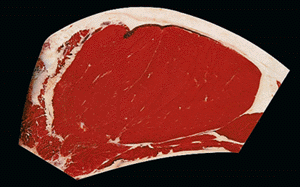 Some of the information in this article comes from the official USDA government web site
Some of the information in this article comes from the official USDA government web site
at http://www.fsis.usda.gov/factsheets/inspection_&_grading/index.asp
USDA inspection is mandatory on all meats which are slaughtered in federal plants and are sold in your meat market(s), even state inspection programs are monitored by the USDA and must at least come up to their standards.
I remember when Michigan still had their own wholesale inspection program and the guidelines for “Made in Michigan” was a lot higher than the federal one’s at that time. If my memory serves me right, out-of-state federal inspected processors were required to actually produce products to these standards, if they wanted to “import” them to Michigan. The quality standard of Michigan made Hot Dogs come to mind here! I cannot find any reference if this ruling is still in effect today.
There are three different inspection marks used,
one for raw meat, you will find this stamp on the whole pieces of meat, which are delivered to your meat market or grocery store.
one for raw poultry and
one for processed meats, this one you will see on all the packaged items which fall under these guidelines, like hot dogs, luncheon meats and even the items which contain more than 3% meat product. So a canned meaty chili or even a glass of spaghetti sauce of a higher than 3% meat content has to be USDA inspected and will have this stamp on the label. When we had our store we cooked and sold nice quantities of Bavarian style Sauerkraut and were thinking of wholesaling it to other stores, the set back was that we added more than the allowed amount of diced bacon to it and would have to go into the federal inspection program, which was not worth the cost and extra headaches at that time.
All these stamps above include the establishment number. This number is assigned by the federal government and is good only for one location. If a large processor has multiple plants, each one has a separate number and can easily be identified.
Let’s say you bought a “private label” ring bologna from a grocery chain, by looking at the stamp you can tell which food processor actually made this product for them!
A published list of these numbers can easily be found on the Internet.
Voluntary Federal inspection for animals not covered under mandatory inspection (i.e., buffalo, rabbit, reindeer, elk, deer, antelope) is handled under the Agricultural Marketing Act.
As meat inspection is mandatory here in the USA, any meat that is sold legally here in the USA should be either inspected by the USDA or under their guidelines by the individual state. This program is paid for by us, the happy taxpayers.
Inspection is mandatory quality grading is voluntary!
Grading
After the meat is ‘inspected and passed’, the processor can have his meat graded. This is voluntary and done by a federal grader who has to be paid for by the processor. This process is strictly for extra quality and if it makes it into a higher grade the meat will also command a higher price.
I copied a quote from the above mentioned website as they wrote it so well:
“USDA grades are based on nationally uniform Federal standards of quality. No matter where or when a consumer purchases graded meat or poultry, it must have met the same grade criteria. The grade is stamped on the carcass or side of beef and is usually not visible on retail cuts. However, retail packages of beef, as well as poultry, will show the U.S. grade mark if they have been officially graded.
The grade symbol and wording are no longer copyrighted; however, according to the Truth in Labeling Law, it is illegal to mislead or misrepresent the shield or wording.”
Of the eight quality grades for beef only the top three, USDA Prime, USDA Choice and USDA Select, are usually graded and sold as primal cuts in the stores.

Prime grade is produced from young, well-fed beef cattle. It has abundant marbling and is generally sold in restaurants and hotels. Prime roasts
and steaks are excellent for dry-heat cooking (broiling, roasting, or grilling).

Choice grade is high quality, but has less marbling than Prime. Choice roasts and steaks from the loin and rib will be very tender, juicy, and flavorful and are, like Prime, suited to dry-heat cooking. Many of the less tender cuts, such as those from the rump, round, and blade chuck, can also be cooked with dry heat if not overcooked. Such cuts will be most tender if “braised” — roasted, or simmered with a small amount of liquid in a tightly covered pan.

Select grade is very uniform in quality and normally leaner than the higher grades. It is fairly tender, but, because it has less marbling, it may lack some of the juiciness and flavor of the higher grades. Only the tender cuts (loin, rib, sirloin) should be cooked with dry heat. Other cuts should be marinated before cooking or braised to obtain maximum tenderness and flavor.
Again the descriptions of the different grades are an excerpt from the official USDA website, this also includes the pictures and graphics used here, which, according to my knowledge, puts them in the public domain.
USDA Select used to be known as USDA Good and this definition was changed years ago. Going back to those times the marbleizing shown in the USDA Prime picture above would then have been considered a mid range USDA Choice and the USDA Select grading in the picture would never have received a USDA Good stamp, but we are told that we live healthier by this as our fat intake came down (lol).
Let’s figure this one out quickly. You own some cattle, you send them to the feeding lot, they get corn fed at a lot higher price than the grass they used to eat, you don’t feed them quite as much corn and get leaner beef, isn’t it natural to lobby to have the standards lowered just a little, to still get the desired USDA Choice grade, which will get you a higher price and let’s tell everybody, that we did it to keep our fellow citizens healthier. Yeah, another good one!
By the way it is not the cattle ranger which benefits from this, but the meat processors.
In the next post I will write about a few things to look for in the meat counter.
